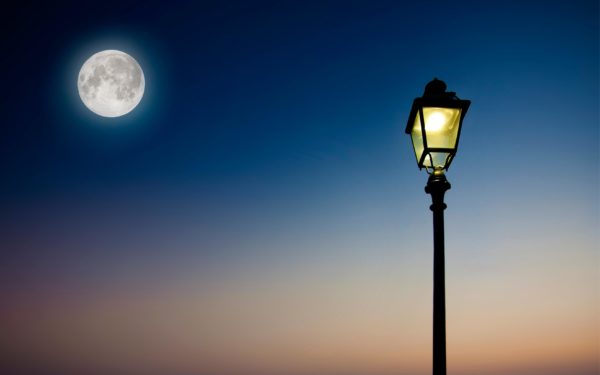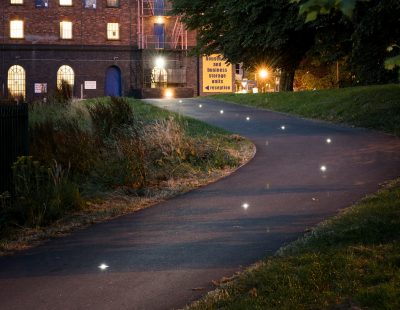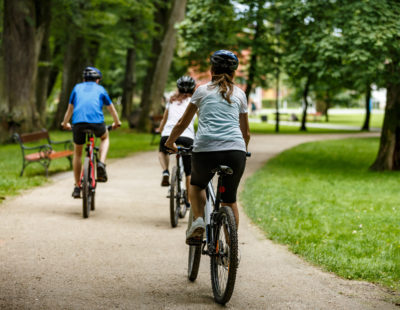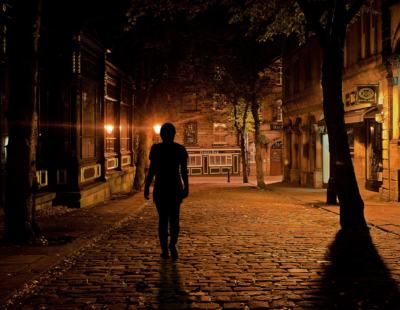Turning everyday journeys into opportunities for exercise has the power to minimise our impact on the environment, improve physical health, and support mental wellbeing. However, for local authorities exploring ways to encourage active travel, it can be difficult to know where to start.
Solareye designs and develops high quality solar lights for local authorities and businesses all over the UK. We know the benefits of properly illuminated public spaces and are committed to helping local authorities create them with the environment always in mind.
In this guide, we explain everything you need to know about active travel and suggest some great ways to facilitate it.
What is active travel?
Active travel is a term used to describe any journey that is made in a physically active way. This could include walking, running, cycling, using a wheelchair, scooting, or even roller-skating. Essentially, any mode of transport that raises your heart rate can be classed as active travel.
Across the UK, local authorities are seeking to encourage active travel in a bid to boost physical health, reduce congestion, and reach climate targets. A key area of focus for active travel are the short journeys we make every day – like the commute, for instance! By incorporating physical exercise into our daily routines, it is much more likely to become a fully embedded behaviour.
See more: Benefits of Cycle Tracks in Towns and Cities
Why is active travel important?
Active travel offers numerous benefits on an individual level and for the wider community. Let’s break down what they are.
Pollution
With more people travelling actively, there will be fewer cars on the roads. That means the local area will see a reduced rate of greenhouse gas emissions, and experience better air quality. Lower levels of traffic will also mean less noise pollution – increasing the auditory comfort of urban areas. The result? Active travel becomes even more appealing!
Congestion
Here’s a fact for you: it would take 66 trees 100 years to absorb the CO2 released if every vehicle in London idled for a single minute (source). Whilst it’s unlikely you will be able to eliminate all journeys made by car in your local area, any steps you can take to reduce congestion will have a positive impact on the environment.
Physical health
Physical inactivity is associated with 1 in 6 deaths in the UK (source), and an estimated 3.2 million deaths per year globally (source). Active travel is an easy way for people to integrate exercise into their daily lives and improve their physical health as a result. Even a short journey can make a tangible difference to someone’s fitness.
Mental wellbeing
Research has found that people who are inactive have 3 times the rate of moderate to severe depression as active people. More than that, active travel often means getting out and about in the fresh air and the natural world – something we know to benefit our mental health and wellbeing.
Community
Active travel is inherently more social than travel by car. With more people out and about on the streets, there will be more opportunities for socialisation and interaction in public spaces. That means active travel has the power to reduce feelings of social isolation and cultivate a more cohesive community.
What are the barriers to active travel?
Despite the many benefits, active travel is not always easy to promote due to a number of barriers. Of these, the most commonly cited is safety. People considering travelling by bike, in particular, are put off by the idea that they will be less safe that they would be in their cars. From busy roads to dangerous driving to personal vulnerability to the fear of being out alone after dark, there are many reasons why people may choose not to participate in active travel. Other factors that can be barriers include low motivation, accessibility issues, and a lack of cycling infrastructure.
How to encourage active travel
Despite the challenges, there are ways to encourage active travel in your community. Below, we highlight some key strategies.
Listen to your community
Find out what the barriers specific to your community are. Encourage people to leave feedback via a survey, online form, or by conducting an in-person focus group. Once you know what the particular issues are for local people, you can take steps to combat them.
Focus on safety
As discussed, safety is often a central concern for people, so focus your attention on this issue. There are a number of steps you can take to make your public spaces safer for pedestrians and cyclists. These include installing traffic calming measures, minimising interactions between cyclists and motorists, and providing well lit cycle tracks and shelters.
Learn more: Facilitating Safety for Pedestrians and Cyclists
Promote the benefits
We know the benefits of active travel, but not everyone does. If people in your community know they might experience better physical and mental health through committing to walking a couple of miles to and from work each day, they might be more likely to give it a go. Formulate a programme for promoting these benefits and get the message out there.
Prioritise pedestrians & cyclists
Typically, infrastructure prioritises motorists – but that doesn’t have to be the story in your area. Provide signage specific to pathways so walkers can easily find their way around the city, increase the presence of cycle lanes, and make sure there are regular crossings. You could also consider installing more street furniture like benches so people who are less physically fit can easily stop and rest before continuing their journey.
Route connectivity
In urban areas, many cycle lanes (if there are any) are incomplete and disjointed, making it difficult to complete a journey entirely in a dedicated lane – once again, leading to safety fears. That’s why it’s important to make sure your cycleways are connected, and there are clear routes for key journeys – for example, between residential areas and schools.
Better infrastructure
Of course, walking can be encouraged with no investment in additional infrastructure. However, if you want to get more people cycling in your community, you’ll need to invest in safe places to lock bikes, well lit bike shelters, and better cycle tracks and pathways.
Discover our solar roof light, perfect for bike shelters! >
Provide well lit pathways & cycle routes
Active travel is one thing in the summer months, but when winter comes around, you don’t want concerns about safety to get in the way of adoption. Eco-friendly solar ground lighting can be installed along cycle tracks to provide comfortable routes for travellers. Easy to install, low cost, and durable, these lights present the ideal solution to promoting safer and healthier travel for all – even in the dark!
LED Solar Lights for Cycle and Bike Paths >
Encourage active travel with quality solar ground lighting
At Solareye, we help local authorities and businesses make public spaces safer and more comfortable for people to use. We’re passionate about finding sustainable solutions to the barriers to active travel, and have developed a range of high performing solar lighting products to help encourage cycling and walking in the dark.
For more information about any of our products, contact us today!
Related: Does Outdoor Lighting at Night Improve Public Safety?
Related: Understanding the Best Options for Public Outdoor Lighting





